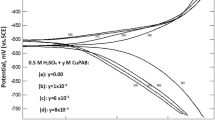Abstract
Inhibition effect of some hydroxytriazenes on copper in nitric acid medium has been studied using weight loss technique at temperature range between 303 to 343 K. The used hydroxytriazene compounds are 3-Hydroxy-3-phenyl-1-(4-sulphonato(sodium salt) phenyl) triazene(HPST), 3-Hydroxy-3-(3-methylphenyl)- 1-(4-sulphonato(sodium salt) phenyl) triazene(HMMPST), 3-Hydroxy-3-(4-methylphenyl)-1-(4-sulphonato (sodium salt) phenyl) triazene (HPMPST), 3-Hydroxy-3-(3-chloroplenyl-(4-sulphonato (sodiumsalt) phenyl) triazene (HMCPST), 3-Hydroxy-3-(4-chloroplenyl-(4-sulphonato (sodiumsalt)phenyl) triazene (HPCPST). Results reveal that inhibition efficiency increases with increasing concentration of hydroxytriazenes from 0.0005 to 0.002 M in following order HPMPST > HPST > HMMPST > HPCPST > HMCPST. HPMPST compound in 0.002M concentration show maximum inhibition efficiency of ~90 at % 303 K temperature. Effect of temperature on inhibition efficiency and thermodynamic parameters have also been reported. The adsorption of hydroxytriazenes obeyed Langmuir Adsorption Isotherm.
Similar content being viewed by others
References
Saini, V. and Kumar, H., Res. J. Chem. Sci., 2014, vol. 4, p. 45.
Prabhakaran, M., Ramesh, S., and Periyasamy, V., Res. J. Chem. Sci., 2014, vol. 4, p. 41.
Fouda, A.S., Haddad, E.L., and Abdallah, Y.M., Int. J. Inno. Res. Sci., 2013, vol. 2, p. 7073.
Ana, T., Simonovi, C., Marija, B., et al., Chem. Pap., 2014, vol. 68, p. 362.
Abdel Rahman, H.H., Moustafa, A.H.E., and Awad, M.K., Int. J. Electrochem. Sci., 2012, vol. 7, p. 1266.
Yurt, A., et al., Ind. Eng. Chem. Res., 2011, vol. 50, p. 8073.
Yanardag, T., Ozbay, S., Dincer, S., and Aksut, A., Asian J. Chem., 2012, vol. 24, p. 47.
Zhang, Q. and Zhongren, Z., Int. J. Electrochem. Sci., 2013, vol. 8, p. 10239.
Gupta, S.L., Dia, A., and Quraishi, M.A., J. Mater. Environ. Sci., 2015, vol. 6, p. 168.
Sherif, E.M., Int. J. Electrochem. Sci., 2012, vol. 7, p. 1884.
Fouda, A.S., Elmors, M.A., Fayed, T., and El Said, M., Res. J. Chem. Sci., 2014, vol. 4, p. 62.
Kumar, S., Garg, M., Chundawat, N.S., et al., J. Chem., 2009, vol. 6, p. 257.
Mistry, M., Patel, N.S., Patel, M.J., and Jauhari, S., Res. Chem. Intermed., 2011, vol. 37, p. 659.
Omyma, R. and Khalifa Shadyia, M., Port. Electrochim. Acta, 2011, vol. 29, p. 47.
Fouda, A., Haddad, M., and Abdallah, M., Int. J. Innov. Res. Sci. Eng. Technol., 2013, vol. 2, p. 7073.
Ahamad, I., Prasad, R., and Quraishi, A., Corros. Sci., 2010, vol. 52, p. 3033.
Patel, N.S., Jauhari, S., Mehta, G.N., et al., Int. J. Electrochem. Sci., 2013, vol. 8, p. 2635.
Li, X.H., Deng, S.D., Mu, G.N., et al., Corros. Sci., 2008, vol. 50, p. 420.
Author information
Authors and Affiliations
Corresponding author
Additional information
The article is published in the original.
Rights and permissions
About this article
Cite this article
Sharma, P., Soni, A., Baroliya, P.K. et al. Inhibition of corrosion of Cu(II) in HNO3 using substituted hydroxytriazene. Prot Met Phys Chem Surf 52, 930–935 (2016). https://doi.org/10.1134/S2070205116050221
Received:
Published:
Issue Date:
DOI: https://doi.org/10.1134/S2070205116050221




